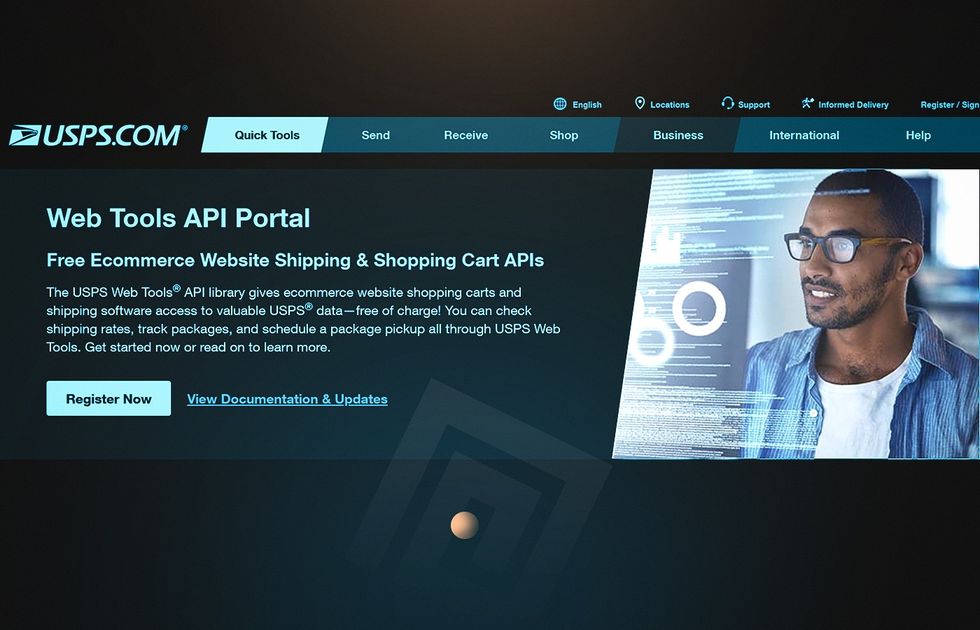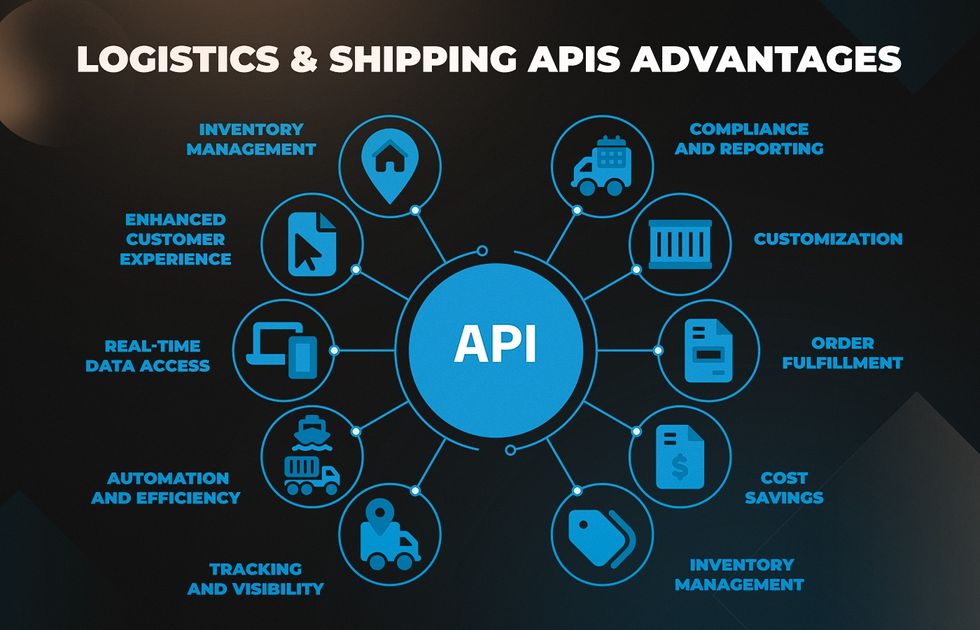
Key Takeaways
- Logistics and shipping APIs are software interfaces empowering businesses to automate their supply chain management processes and enhance their existing assets.
- By integrating shipping APIs, e-commerce, retail, and supply chain businesses can operate with a unified system of various synchronized tools.
- Successful integration of logistics APIs enables tracking transparency, real-time data processing, cost savings, and customer experience improvement.
When digitalizing supply chain-related operations, businesses utilize a set of automation tools, with each performing specific tasks to satisfy end-users. To ensure smooth communication between a company’s existing assets and a provider’s software, they invest in shipping API integration.
As carriers, manufacturers, and e-commerce agents interact on the common landscape using various tracking apps, they require a centralized workflow. This is where API integration comes in to help third-party logistics providers. APIs are especially useful if you need to establish a cohesive and seamless interconnection of your software with a carrier’s system. However, successful implementation is a complex process requiring a reliable web vendor.
At Acropolium, we’ve been developing software for logistics, integrating custom and ready-made solutions in existing tech ecosystems for 20+ years. In this article, we’re diving deep into all things logistics API.
Read on to explore the real-life examples of API integration and learn how your business can benefit from it!
Global API Management Market Size
The Global API Management Market is rapidly growing, going from USD 3.28 billion in 2022 to an expected USD 12.9 billion by 2030. This significant growth is driven by the increasing digitization of industries, leading to a strong projected 18.76% CAGR.
What Is a Shipping API? Definition & Use Cases
A shipping API (Shipping Application Programming Interface) encompasses a set of standards and protocols used to seamlessly connect diverse software platforms. It empowers companies to integrate e-commerce platforms, warehouse management systems, or other software with carrier systems for efficient shipment data exchange.
By integrating retail and shipping platforms with courier services through shipping APIs, customers can monitor order progress in real-time. Furthermore, such practice helps you automate order shipping, package tracking, and return management processes.
Shipping API integrations address the needs of different businesses participating in supply chain activities, which include:
- E-commerce retailers: shipping tracking APIs ensure timely deliveries by accessing shipping rates, tracking packages, and managing inventory.
- Manufacturers: Logistics APIs optimize supply chains and cut transportation costs by enabling effective coordination of raw materials and finished products within the chain.
- Distributors & Wholesalers: Goods distribution companies utilize APIs to connect with inventory management systems to streamline order fulfillment and inventory monitoring.
- Third-party logistics (3PL): Software for freight brokers’ APIs connect businesses with transportation systems and automate shipping, enhancing supply chain visibility.
- Transportation Companies: APIs that integrate trucking dispatching software provide online booking, shipment tracking, and real-time delivery updates.
Common Logistics and Shipping APIs
Shipping API integration complexity depends on the features you require, your specific objectives, and the usability of the chosen software. Each API provider offers a different scope of functionality and is suitable for various business sizes and their activities.
Aiming to automate and revolutionize logistics and shipping processes, businesses invest in shipping API integration with the following world-renowned courier companies:
- FedEx
- UPS
- DHL
- USPS
FedEx

The FedEx Shipping API is a software interface provided by FedEx — a global courier and logistics company. It allows businesses to integrate FedEx’s shipping services into their applications, websites, or systems. The software enables users to access FedEx’s shipping, tracking, and label generation capabilities.
Businesses can use the FedEx Shipping API to calculate shipping rates, create shipping labels, track packages in real-time, and manage various aspects of their shipping operations, making it a valuable tool for e-commerce, logistics, and supply chain management.
Best for: small, mid-sized, and large businesses
Key features:
- Clients can tailor shipping options, such as branded labels or custom shipping preferences, to their specific needs.
- The software is compatible with e-commerce, transportation, and supply chain management software
- It serves as a shipping calculator API, providing accurate shipping rates based on package details, destination, and service type.
- The label generation feature allows the creation of shipping labels directly through the API.
- The software offers real-time package tracking and delivery status updates.
- It simplifies international shipping with automated customs documentation.
- This API allows for tailoring shipping preferences, labels, and service options to meet specific business needs.
UPS

The UPS integration API is a tool provided by UPS — one of the largest and most recognized shipping companies. This software is designed to facilitate integration with their shipping services. It allows businesses to access UPS shipping functionalities, such as real-time rate calculation, label generation, tracking, and more. This API is used to streamline and automate shipping processes, making it more efficient and cost-effective for businesses of all sizes.
Best for: small, mid-sized, and large businesses
Key features:
- APIs streamline shipping processes, reducing manual tasks and improving order fulfillment speed.
- Real-time rate calculation and optimized shipping options help reduce transportation expenses.
- UPS offers international shipping options, expanding clients’ global reach and market access.
- Clients can customize shipping preferences and labels, aligning services with their unique needs.
- Integration with UPS APIs helps clients manage inventory effectively, reducing stock-related issues.
DHL

The DHL shipping API is a tool that allows businesses to integrate with DHL’s delivery services. It offers real-time rate calculation, label generation, tracking, and customs documentation. This API is used to streamline shipping processes and manage domestic and international shipments in businesses of any size.
Best for: small, mid-sized, and large enterprises
Key features:
- Accurate shipping rates based on package size, weight, destination, and shipping service.
- Label generation directly through the API, streamlining the labeling process.
- Real-time package tracking and delivery status updates to enhance transparency.
- The software’s customs documentation feature smoothens international shipments with automated paper processing.
USPS

The USPS shipping API allows businesses to integrate with the shipping company’s tracking and inventory management services. Like previous software examples, it encompasses rate calculation, label generation, tracking, and address validation. The software is used to streamline shipping processes, manage postage, and enhance delivery services within the United States.
Best for: US businesses of any size
Key features:
- Provides real-time shipping rate calculations based on package weight, size, and destination.
- Enables the generation of shipping labels directly through the API.
- Allows real-time package tracking and delivery status updates.
- Helps validate and standardize addresses, reducing delivery errors.
- Facilitates the purchase and printing of postage labels for various mail classes.
- Compares shipping rates across different USPS services to find the most cost-effective option.
Advantages of Using Logistics and Shipping APIs

Automation and transparency operations have long been the biggest logistics technology trends before becoming the new normal. In order to organize a productive and all-encompassing supply chain workflow, logistics, and e-retailers use various tools and software simultaneously.
At this point, automation that unifies all the tech assets into a standardized system is crucial for operational efficiency. However, visibility is not the only advantage businesses can embrace using shipping tracking APIs.
Real-time Data Access
Freight APIs provide access to real-time information, such as shipping rates, tracking data, and inventory levels. This data enables informed decisions and helps respond proactively to business landscape changes.
For instance, an API connects e-commerce stores and marketplaces to carrier systems for real-time rate comparison, label printing, and tracking.
Tracking and Visibility

Delivery APIs enable live monitoring and visibility of shipments. This feature allows businesses to track product delivery as it moves to its destination, providing timely customer updates.
The renowned eBay platform integrates multiple shipping APIs. This way, the company enables sellers to connect with several carriers for streamlined shipping and tracking within one system.
Automation and Efficiency
Transportation APIs automate various logistics and shipping processes, reducing manual data entry and repetitive tasks. As part of logistics software modernization, it can improve operational efficiency and reduce human error risks.
Postmates, a food delivery and courier service, offers delivery API integration software to connect customers, merchants, and couriers. As a result, it automates order placement, real-time tracking, and payment processing, ensuring a seamless delivery experience.
Enhanced Customer Experience
With shipping API for ecommerce websites, businesses offer customers accurate shipping cost estimates, delivery timeframes, and live tracking information. Such transparency can enhance the customer experience and build trust.
For example, Etsy uses the USPS shipping API to help sellers generate shipping labels and calculate postage costs directly from their Etsy shop.
Inventory Management
Logistics APIs help businesses track and manage inventory levels immediately. This ensures that products are adequately stocked, reducing the overstocking or understocking risks.
Such giants like Amazon already utilize the functionality, allowing sellers to integrate their order management systems with Amazon’s logistics network.
Order Fulfillment Optimization

Logistics API integration can assist in optimizing the order fulfillment process by selecting the most efficient shipping methods and carriers based on factors like delivery speed and cost.
Shipping and order fulfillment software can integrate with e-commerce platforms and major carriers via a single API. Such APIs allow for label generation and rate calculations, keeping all the essential assets within one system.
Compliance and Reporting
Trucking APIs often have built-in features for generating compliance documents and reports required for customs, regulatory authorities, and auditing purposes. This minimizes the risk of legislation errors in freight forwarding software and other essential logistics tools.
Customization
Many logistics and shipping APIs can be customized to meet a business’s specific needs and branding, providing a tailored user experience.
Popular automation platforms like Zapier integrate with FedEx and DHL APIs to provide their customers with custom automation for shipping. This enables their users to adjust workflows and order fulfillment to serve their business objectives.
When paired with custom software tailored to your operational focus, you can connect as many APIs as you need. Therefore, you will operate with a flexible system that cooperates with other logistics tools.
Cost Savings
Access to shipping APIs can help businesses compare carrier shipping rates and choose the most beneficial options. When integrated into transportation management software, this function contributes to cost savings and improved profitability.
How to Integrate Logistics and Shipping APIs: A Step-by-step Guide

A successful API integration requires technical proficiency and a deep understanding of your business requirements and processes.
First off, familiarize yourself with software options that support transportation API integration:
- Transportation management systems (TMS)
- Warehouse management systems (WMS)
- E-commerce platforms
- Inventory management software
- Multi-Carrier shipping software
- Third-party logistics (3PL) software
- Last-mile delivery and route optimization software
- Freight brokerage software
Integration requires careful planning, testing, and maintenance to meet business objectives efficiently. Here are the fundamental steps you shouldn’t skip when considering logistics API integration:
1. Needs identification
Determine which logistics and shipping APIs are required based on your goals. Analyze what part of your operational routine requires automation and could be optimized for better efficiency.
2. API Selection
Research and choose APIs from reputable carriers, logistics service providers, or shipping platforms that align with your objectives. If you leave the process up to a web development vendor, they will provide you with the most effective options.
3. API Access
Sign up on the chosen logistics API platform and register for access with the selected providers. This usually involves creating developer accounts and requesting API keys or access credentials. If your in-house team doesn’t have the required expertise, it’s advisable to outsource the process to an integration partner.
4. API Documentation
Read the API documentation provided by the carrier or logistics service. Study the endpoints, data formats (e.g., JSON or XML), authentication methods (e.g., API keys or OAuth), and rate limits or usage restrictions. Note that this part will be handled by a third party when referring to shipping API integration services.
5. Integration Plan
Outline your integration strategy. Decide where the shipping API integration will occur within your operations, and plan for the technical resources and development efforts required.
6. Integration Code
Depending on your technology stack and platform, you must write code to integrate the API into your business systems. This can be achieved with programming languages like Python, Java, Ruby, SDKs, or API-provided libraries.
If you delegate the process to an outsourcing or offshore development company, you will get the required expertise promptly and implement integration faster.
7. Testing & Error Handling
Test your API integration thoroughly in a controlled environment. Make sure that your integration partner verifies that it can make successful API requests and errors.
Implementing robust error-handling mechanisms to deal with freight shipping API issues, network problems, and other unexpected events is imperative. Usually, third-party development companies implement proper logging to track API calls and responses continuously.
Challenges and Solutions in API Integration
API integration poses several challenges, including complexity, data mapping difficulties, security concerns, error handling, and rate limit restrictions. To address these challenges, businesses cooperate with software development agencies, where expert developers leverage middleware for data transformation.
Since web providers match businesses with the latest tech expertise, you can have strong security measures implemented for you. At the same time, the dedicated team will develop robust error handling mechanisms and manage API rate limits effectively.
Why Implement Logistics and Shipping APIs integration
Implementing logistics and shipping APIs integration provides businesses with several advantages. It streamlines operations, reduces manual effort, and minimizes errors through automation. APIs offer real-time data access, enabling prompt decision-making and improving efficiency.
For example, Shopify, an e-commerce platform, integrated multiple shipping APIs, including USPS, FedEx, and UPS. This allowed their merchants to offer real-time shipping rates, label generation, and order tracking directly through their online stores.
Logistics platforms provide businesses with an API to connect with various shipping carriers. With simple tools for rate comparison, label generation, and order tracking, their customers optimize routine tasks within a few clicks.
Furthermore, supply chain businesses that use logistics API’s real-time tracking for freight shipments can easily track and manage their loads. Thus, companies improve operational efficiency and customer service.
Final Thoughts
API integration plays a major role in building a cohesive and seamless connection between your software and a carrier’s system. To uncover the full spectrum of integration benefits, companies turn to web development and IT outsourcing providers.
Acropolium, a prominent provider of bespoke IT solutions for transportation businesses, has successfully delivered 20+ comprehensive solutions to industry leaders. Adhering to the strictest ISO standards and utilizing GDPR-compliant software, we seamlessly integrate logistics APIs into our clients’ systems.
Our skilled teams have decades of experience developing custom freight forwarding, fuel management, and other software supporting API integrations. Prioritizing our partners’ budget constraints and software needs, we offer a subscription-based cooperation model.
Get in touch with us to strengthen your logistics tools and take your operations to the next level!









![How to choose the Best Transportation Management Software [2025 Guide]](/img/articles/best-transportation-management-software/img01.jpg)
![AI Route Planning in 2025: [Use Cases & Benefits]](/img/articles/ai-route-planning/img01.jpg)
![IoT in Fleet Management: [Use Cases, Trends & Case Studies]](/img/articles/employing-iot-for-fleet-management-benefits-use-cases-and-success-stories/img01.jpg)

![Load Planning Software: [Features, Types and Benefits]](/img/articles/load-planning-software-features-types-and-benefits/img01.jpg)
![AI in Warehouse Management: [Benefits & Use Cases]](/img/articles/ai-in-warehouse-management/img01.jpg)